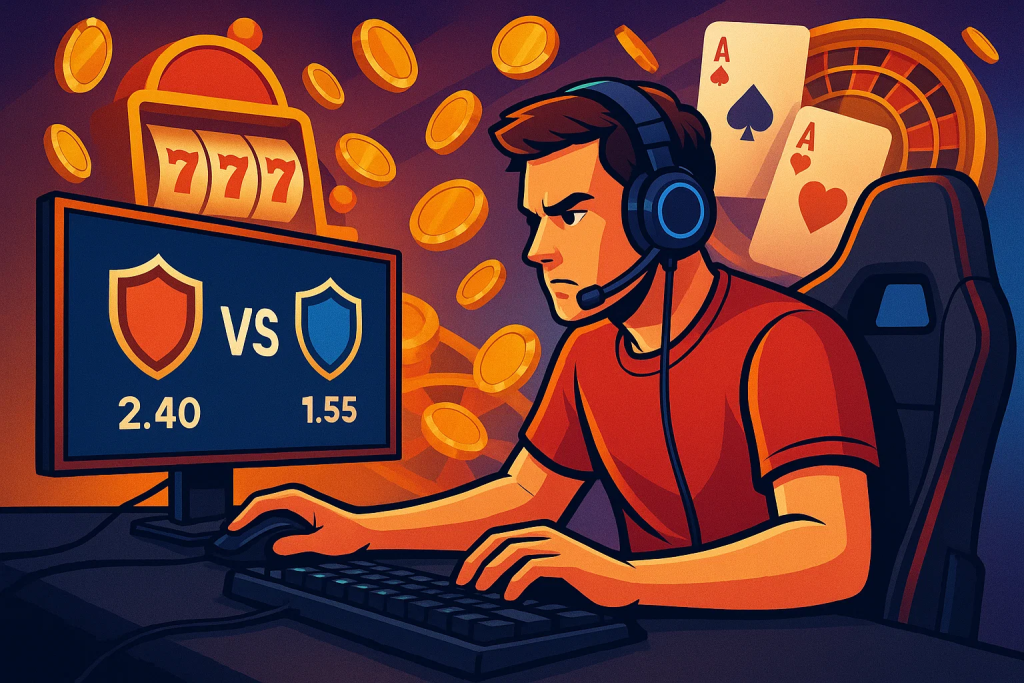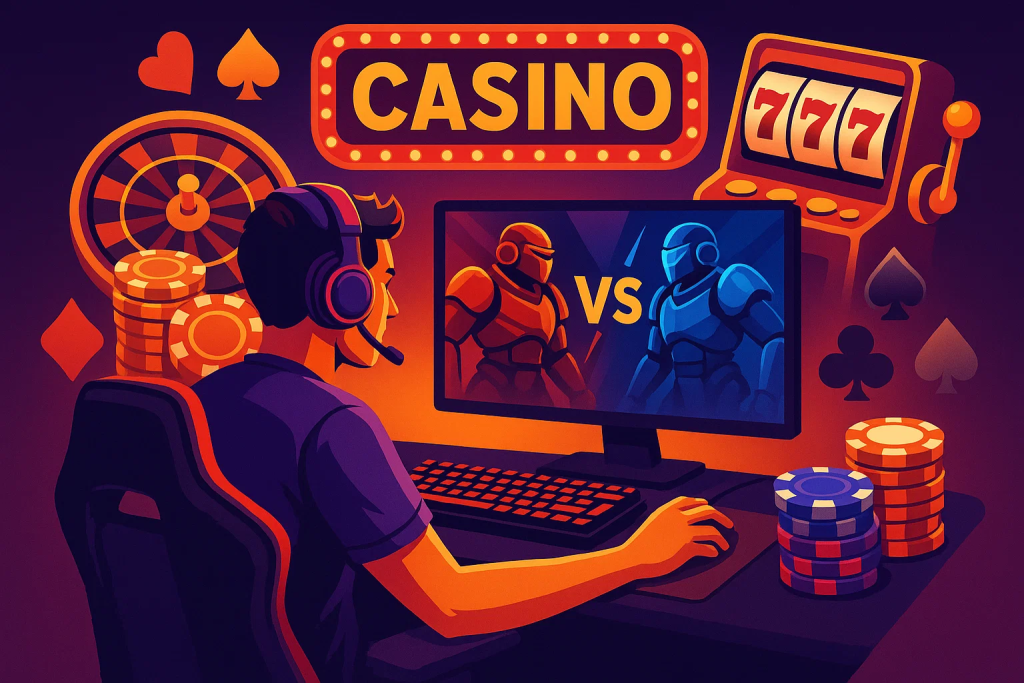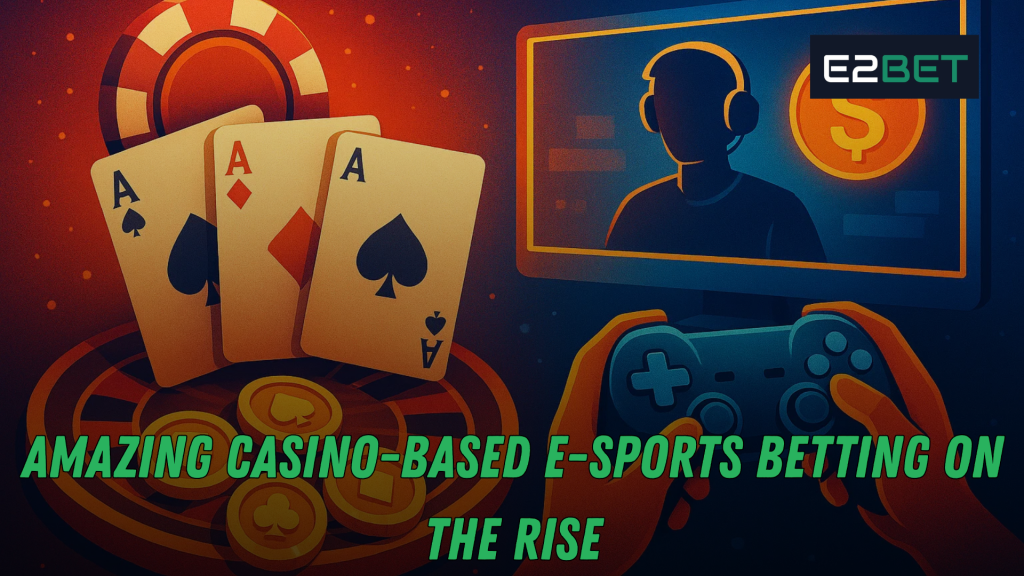Why Casinos Are Leaning Into Digital Sport
The most promising bridge between traditional sportsbooks and new audiences is e-sports betting. Casinos are rethinking how they fill their calendars, diversify their guests, and modernize their retail books. It marries year-round competitive schedules with broadcast-ready content and a fan culture that already lives online. At the same time, casino properties supply what the gaming community still struggles to scale on its own: compliance, payments, identity verification, and theatrical venues that turn a screen into a shared ritual of cheering, analysis, and post-match debates. Done correctly, e-sports betting becomes a fresh demand engine for hospitality, F&B, retail books, and even midweek entertainment slumps.

Yet this momentum only matters if it’s sustainable. That means clear definitions, pragmatic product design, integrity by default, and guest education that doesn’t talk down to newcomers. This article is a field guide for property leaders, sportsbook managers, and marketers who want to implement a responsible, compliance-aligned plan from day one.
What We Mean by “Casino-Based E-sports”
Before you sketch contracts or buy LEDs, align language across departments:
- E-sports: sanctioned competitive play in titles such as League of Legends, Counter-Strike, Valorant, Dota 2, or NBA 2K.
- Casino-based e-sports: tournaments, showcases, or watch parties hosted within or allied to a licensed property—arenas, theaters, lounges, or sportsbook footprints.
- e-sports betting: regulated wagering on e-sports events through licensed retail or mobile books, governed by the same KYC, AML, and safer-play controls as traditional sports.
- Integrity frameworks: codes, monitoring, and sanctions that deter cheating or match-fixing, with responsibilities distributed among tournament organizers, data vendors, and the sportsbook.
- Occasion design: the choreography that turns an event into an evening—greeters, explainer reels, post-match meetups, and themed F&B.
When your compliance lead, sportsbook traders, marketing team, and venue ops speak the same language, vendor pitches become easier to audit and your e-sports betting policies stop drifting with the hype cycle.
Why Casinos Have an Advantage
Casinos already excel at the three pillars this vertical needs:
- Regulated trust – Licensed properties operate under strict rules and audits. Guests intuitively understand that a casino has oversight and recourse, a foundation that makes new markets, like e-sports betting, less intimidating.
- A stage for digital sport – Purpose-built theaters, lounges, and sportsbooks keep fans together, amplifying energy and dwell time. That context is ideal for onboarding newcomers with “watch-then-try” programming and gentle product education that positions e-sports betting as an optional enhancement rather than the main act.
- Hospitality muscle – From ticketing flows to sound design, properties know how to make a match feel like an occasion. They can layer pre-show primers, halftime explainers, and post-show Q&A with creators or coaches, turning one-off curiosity into a recurring ritual.
Market Drivers You Can Actually Model
Calendar density: E-sports runs all year, producing frequent tentpoles for content and programming.
Young adult reach: Audiences in their twenties value hybrid experiences—live hospitality plus digital immersion.
Content flywheel: Every event produces clips, recaps, and behind-the-scenes assets for your channels.
Weeknight filler: Tuesday and Wednesday nights, historically soft for many casinos, can host “learn the meta” scrims or collegiate showcases that feed the weekend’s marquee cards.
All of these are measurable. Track dwell time uplift, beverage attach rates, first-time versus repeat attendee ratios, and retail-to-mobile conversion. Tie improvements back to event formats, not just titles.
Regulatory Reality: Cautious Momentum
Laws differ by jurisdiction. Some regulators already allow e-sports markets within existing sportsbook frameworks; others require event-by-event approvals or are drafting specific guidance. The common pattern: careful expansion when operators can document integrity measures, age controls, data provenance, and clear settlement rules. Build an internal memo that answers:
- Which events qualify within your jurisdiction?
- What approvals or notifications are required?
- How will you validate data sources and sanctioning bodies?
- Where will age-restricted activities sit inside the venue?
The more thoroughly you answer these questions, the easier it becomes to position e-sports betting as a logical extension of your current book rather than an exotic tangent.
Integrity by Default: Your Non-Negotiable Pillar
Sustainable programs hard-wire integrity into every contract and schedule. That means:
- Codes and membership – Align with recognized integrity bodies, and require adherence from any tournament organizer you host.
- Monitoring and alerts – Lean on trading analytics and real-time odds movement to flag anomalies; have the authority and SOP to pause or decline markets when something looks off.
- Segregation of duties – Keep clear lines between event production, integrity monitoring, and trading.
- Transparency with guests – Display settlement rules, data sources, and approval notes in plain language. Teaching guests how outcomes are determined builds confidence in e-sports betting without drowning them in jargon.
Product Design: Keep It Approachable
Resist the urge to overwhelm first-timers with insider markets. Instead:
- Start simple: match winner, handicap, totals, series length.
- Translate terms: if a prop uses in-game language, add a parenthetical (“first objective = first tower/dragon/baron,” depending on title).
- Retail vs. mobile: keep retail boards concise; let your app host deeper menus once literacy improves.
- Settlement clarity: write rules in plain English and post them where guests can actually see them.
Great retail UX makes e-sports betting feel like sports fandom, not a puzzle.
Venue Strategy: Arena, Lounge, or Hybrid?
Arena model – A flexible theater with production control lets you run tournaments, creator nights, collegiate showcases, and finals watch parties. Even on non-wagering nights, the arena acts as a cultural anchor and incubator of your next big tentpole.
Lounge model – A smaller footprint with pods, booths, and big screens adjacent to the sportsbook. Ideal for recurring “learn-and-watch” meetups, controlled scrims, and creator viewing nights.
Hybrid sportsbook model – Integrate e-sports slates into the same sightlines as soccer and basketball, but give them a distinct visual identity and explainer reels. Place trained ambassadors nearby to onboard new guests.
Pick based on your market, not on vendor FOMO. Program first, buy screens later; without a calendar, hardware gathers dust. Thoughtful lounge design turns curiosity into confidence and eases guests into e-sports betting one clear step at a time.
Technology Stack: Data, Odds, Content, Controls
You don’t need every bell and whistle on day one, but you do need a coherent stack:
- Data feeds – Use official or reputable sources with auditable provenance and clear latency disclosures.
- Trading tools – Your risk engine must handle patch-driven meta shifts and uneven event structures.
- Content pipeline – Live production plus VOD capture for highlight reels, explainers, and SEO-friendly recaps.
- Compliance & RG – Mirrors your existing sportsbook controls with age verification, exclusion options, time and spend limits.
Document how these blocks connect. If an anomaly arises mid-event, your SOP should allow trading to halt markets while integrity teams investigate—an everyday discipline that strengthens trust in e-sports betting far more than any marketing campaign.
Marketing That Educates, Not Over-Promises
Positioning matters. Treat marketing as a literacy program:
- Lead with “watch then try” content: 60-second primers on roles, maps, and win conditions.
- Write human microcopy: “First time watching? Start here.”
- Set visible guardrails: age gating on assets, safer-play messages, and clear eligibility notes.
- Showcase people, not just prize pools: creator stories, collegiate athletes, and behind-the-scenes staff. Personality makes the sport accessible, while understated tone keeps e-sports betting in perspective.
Responsible Play: Protect Attention, Protect Guests
Reputation is won or lost here. Translate casino-grade safeguards into the esports context:
- Age and space – If your event includes under-21 participants or spectators, ring-fence any wagering zone with clear signage and controlled access.
- Limits by design – Encourage time and spend limits; surface reality checks in the app; train ambassadors to explain them without stigma.
- Help pathways – Provide simple ways to pause, self-exclude, or access support.
- Staff training – Prepare moderators and frontline staff to de-escalate conflicts and respond to harassment swiftly.
Responsible guardrails do not dampen excitement; they enable it. They show newcomers that your property is a safe place to learn, cheer, and—if they’re eligible—explore e-sports betting with confidence.
The 12-Month Rollout Roadmap
Quarter 1 – Discovery and Guardrails
- Confirm jurisdictional permissions with your regulator. Catalog which titles and events are eligible and what approvals are needed.
- Draft an internal policy that binds any esports partner to integrity codes, data standards, and safeguarding norms.
- Pilot two non-wagering events to test production flow, audience appetite, and the “watch-then-try” onboarding. Use surveys to learn what confused or delighted guests about e-sports betting even if you didn’t open markets yet.
Quarter 2 – Soft-Launch, Simple Menus
- Secure approvals for two marquee weekends. Offer straightforward markets only—winner, totals, handicap—and post a two-minute primer loop on screens.
- Station ambassadors near the lounge to answer questions one-on-one. Confidence grows fastest through human interaction, not banners.
- Bundle F&B packages that fit match flow. Measure dwell time, beverage attach rates, and first-time-to-repeat conversion, then map these against your e-sports betting handle and hold.
Quarter 3 – Optimize and Expand
- Add a collegiate showcase or academy finals to diversify formats.
- Introduce limited mobile-only props for educated guests while keeping retail boards clean.
- Publish a mid-year transparency note with integrity outcomes, safer-play usage stats, and top learnings from the first six months of e-sports betting integration.
Quarter 4 – Scale Responsibly
- Lock a seasonal calendar with two predictable tentpoles per quarter.
- Upgrade the lounge or micro-arena only after programming proves repeatable.
- Build next-year RFPs around lessons learned, emphasizing flexible formats, strong compliance, and co-marketing that highlights how your property approaches e-sports betting as part of a broader entertainment mix.

KPIs That Correlate With Durable Growth
- Event approvals granted and time-to-approval
- Retail footfall vs. baseline and dwell time lift
- Handle and hold by title, not just by weekend
- New-to-sportsbook share and retail-to-mobile conversion
- Settlement speed and integrity alerts resolved without incident
- RG tool usage and time-to-support response
- Guest satisfaction by event and by venue zone
Ignore vanity metrics like raw impressions that never convert to attendance or play. Track behaviors that demonstrate understanding and comfort around your events and your e-sports betting product.
Risk Register: Where Operators Get Tripped Up
- Integrity shortcuts – Hosting unsanctioned events or declining third-party monitoring jeopardizes licenses and trust.
- UX bloat – Overloading retail boards with inside-baseball jargon chases away curious adults who might otherwise try a simple market.
- Youth adjacency – Blurred lines between teen showcases and adult wagering zones invite confusion and complaints; your layout and signage must be unambiguous.
- Operational drift – Treating esports as a “side project” without an owner. Assign a cross-functional lead with authority to balance production, compliance, and trading for e-sports betting nights.
Case Signals: Culture Hubs, Not Just Bet Shops
Properties that succeed in this space behave like theaters with seasons. They publish a calendar, nurture creator relationships, and treat every event as a content shoot. Over time, the audience begins to see the casino as a convening space for digital sport—not just a place to place a ticket. In that context, simple, well-explained e-sports betting becomes a natural extension of fandom, not a gamble into the unknown.
Guest Journey: From Curiosity to Confidence
- Discovery – A short primer video highlights roles and win conditions, followed by a clear invitation to a watch party in a welcoming lounge.
- On-Property Orientation – Greeters hand out “new viewer” cards with a QR to a glossary. Ambassadors answer questions and point out where age-restricted activities are located.
- Shared Viewing – Themed food, live casting, and quick explainer segments create context.
- Optional Onboarding – For eligible guests, a two-minute briefing explains retail boards and simple markets.
- Aftercare – A thank-you note with highlight clips, a “learn more” primer, and next-event RSVP. This cadence helps first-timers convert to regulars without pressure, gradually preparing them for e-sports betting if they choose to participate.
Executive One-Pager: The Business Case
- Demographics – Reach 21–34 audiences who value hybrid entertainment.
- Calendar – Fill weeknights and shoulder seasons with programmable content.
- Content flywheel – Reusable reels fuel social, CRM, and SEO for months.
- Compliance fit – Extend existing sportsbook controls to a new but compatible set of events.
- Revenue mix – Incremental F&B, sponsorships, and a measured ramp in e-sports betting handle—anchored by guest education and clear guardrails.
Messaging Templates You Can Re-Use
Event landing copy:
“Learn the game at 5 pm, cheer the finals at 6 pm. New to the title? Our two-minute primer on the big screens will get you ready. Guests 21+ can explore the retail board with a host on-site.”
On-screen primer copy:
“This best-of-five is simple: first to three wins. Retail boards list ‘match winner’ and ‘map totals.’ Ask our ambassadors for a quick guide.”
Responsible-play tag:
“Set a limit before you start. Take breaks. If it stops being fun, pause and talk to our team.”
These snippets keep language human, remove intimidation, and align your culture with hospitality rather than hype.
SEO Checklist for Your Esports Hub
- Core intent clusters – “What is [title],” “how to watch [title] at [property],” “beginner’s guide to [title].”
- Evergreen explainers – Glossaries, role guides, and simple betting primers that write with clarity and link to event pages.
- Schema – FAQ and Event markup so calendars surface in search.
- Interlinking – Connect post-event recaps to upcoming events and to your safer-play hub.
- Tone – Write for people first. Search engines reward content that answers questions cleanly and consistently.
Content Pillars to Keep Weekly
- On-ramp education – 60-second clips and pocket guides.
- Behind the scenes – Staff, casters, and creator spotlights.
- Skills and scrims – Controlled practice nights that welcome newcomers.
- Community and care – Moderation wins, safer-play reminders, and accessibility notes.
- Celebrate the bridge – “From lounge to sportsbook” explainers that normalize optionality and keep e-sports betting in proportion.
Budget Where It Matters
Invest first in people and policies, not neon:
- Ambassadors and moderators – They are your conversion engine and safety net.
- Production basics – Audio, stable cams, readable overlays.
- Venue flow – Clear signage, accessible seating, and an easy path from greeting to viewing.
- Accessibility – Captions, color-blind friendly palettes, wheelchair access, and beginner cohorts.
The result is a space where first-timers feel respected, returning guests feel proud to bring friends, and your e-sports betting program grows at the speed of trust.
Cross-Functional Playbook: Who Owns What
- Compliance – Defines what can be booked, approves third-party vendors, and audits SOPs.
- Sportsbook – Chooses markets, sets limits, and steers risk controls.
- Esports Production – Runs formats, liaises with teams or TOs, and guarantees show quality.
- Marketing/CRM – Converts discovery into RSVPs and keeps the content flywheel spinning.
- Hospitality – Designs F&B and manages traffic, cleanliness, and comfort.
- Executive Sponsor – Shields the program from “initiative drift,” holds the calendar, and reviews quarterly dashboards.
When responsibilities are explicit, everything from door staffing to settlement clarity tightens—and that tightness is what makes newcomers comfortable exploring e-sports betting inside your walls.
Five Composite Mini-Scenarios (Names Changed)
Riverside Lounge: A regional property launched monthly creator nights with on-screen primers and a post-show Q&A. Dwell time rose 35%, and first-time attendees returned within three weeks. The sportsbook added one simple market on marquee weekends and watched questions turn into confidence.
Summit Theater: The property built a micro-arena after two quarters of repeatable programming. Because the calendar existed first, production ROI was immediate: every event produced clips that powered CRM and organic search for six months.
Coastal Casino: A collegiate showcase attracted families and under-21 fans. The venue ring-fenced wagering zones and trained greeters to answer eligibility questions. The result: high satisfaction scores and zero confusion complaints.
Harbor Sportsbook: Retail boards used plain English and two big markets only. The app carried deeper menus for experienced guests. Handle grew steadily while support tickets stayed low—evidence that clarity beats cleverness.
Desert Resort: After an integrity review flagged a questionable third-party event, the property declined to book markets and published a short note explaining standards. Trust rose precisely because the answer was “not this time.”
Casino Revenue Drivers: Brilliant Slot Machines versus Table Games
Call to Action
Block 60 minutes this week with your compliance lead, sportsbook manager, and venue ops. Agree on a one-page position—what you can approve, what you’ll pilot, and what you’ll decline. Choose two calendar dates for low-stakes “watch-then-try” programming. Assign one owner for guest education assets and one for moderation. Publish your code of conduct, safer-play resources, and a simple event FAQ. Then run your first night, listen hard, and iterate. Momentum follows clarity.

Frequently Asked Questions (FAQ)
1) Is wagering required to run an esports night?
No. Many properties start with non-wagering showcases to grow literacy and confidence. When the audience understands the sport and your staff understand the flow, introducing simple retail markets becomes natural.
2) How do we keep first-timers from feeling lost?
Use greeters, explainer reels, and “ask me anything” desks. Create a buddy system led by ambassadors. End each event with a “one thing I learned” share-out and post a recap within 24 hours so newcomers feel seen.
3) What titles work best for a mainstream audience?
Pick games with clear win conditions, robust broadcast tools, and reliable event calendars. Then build explainers that translate roles and objectives in plain English—your content habits matter more than the exact title.
4) How should we price tickets for watch parties?
Keep entry affordable and make value obvious: reserved seating, themed snacks, meet-the-caster time, and a printed quick-start guide. Consider free first-timer nights funded by sponsors who share your safer-play and accessibility standards.
5) What’s the fastest way to show seriousness about safeguards?
Publish a code of conduct, age-restricted zone policy, and a simple report pathway. Train staff on de-escalation and response times. Make your standards visible on screens before the show and at the door—clarity creates comfort.
